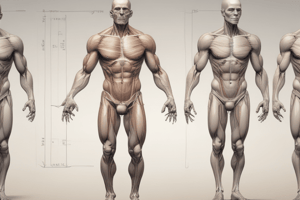Podcast
Questions and Answers
What is the primary function of the rectus abdominis muscle?
What is the primary function of the rectus abdominis muscle?
- Stabilization of the pelvis
- Flexion of the lumbar spine (correct)
- Rotation of the thoracic spine
- Extension of the lumbar spine
Which muscle is NOT mentioned as being connected to the Thoraco-Lumbar Fascia (TLF)?
Which muscle is NOT mentioned as being connected to the Thoraco-Lumbar Fascia (TLF)?
- Gluteus Maximus
- Pectoralis Major (correct)
- Multifidus
- Latissimus Dorsi
What is the function of the Thoraco-Lumbar Fascia (TLF) in relation to the lumbar spine?
What is the function of the Thoraco-Lumbar Fascia (TLF) in relation to the lumbar spine?
- To flex the lumbar spine
- To provide 3D support to the lumbar spine (correct)
- To stabilize the pelvis
- To extend the thoracic spine
Which muscle is responsible for forming a 'hoop' around the abdomen?
Which muscle is responsible for forming a 'hoop' around the abdomen?
What is the function of the Transverse Abdominis muscle?
What is the function of the Transverse Abdominis muscle?
Which muscle attaches proximally at ribs 5-7 and the xiphoid process?
Which muscle attaches proximally at ribs 5-7 and the xiphoid process?
What is the result of simultaneous contraction of the diaphragm, pelvic floor muscles, and abdominal muscles?
What is the result of simultaneous contraction of the diaphragm, pelvic floor muscles, and abdominal muscles?
Which muscle is part of the deep muscles of the back and trunk?
Which muscle is part of the deep muscles of the back and trunk?
What is the benefit of the Thoraco-Lumbar Fascia (TLF) in relation to integrated kinetic chain activities?
What is the benefit of the Thoraco-Lumbar Fascia (TLF) in relation to integrated kinetic chain activities?
Which muscle is NOT one of the abdominal muscles mentioned in the content?
Which muscle is NOT one of the abdominal muscles mentioned in the content?
Flashcards are hidden until you start studying
Study Notes
Back Muscles
- The quadratus lumborum is active in lateral stability of the lumbar region and acts as a restraint to lateral shear of the vertebrae.
- It is also a weak lateral flexor of the lumbar spine.
Latissimus Dorsi
- Plays a role in core stability with overhead movement.
- Has attachments to the lumbar spinous processes through its integration with the thoracolumbar fascia.
- Active in providing core stabilization with trunk extension and quadruped exercises.
Multifidus
- Originates from sacrum, lumbar, and cervical transverse processes.
- Inserts into spinous processes of all vertebrae.
- Actions: extension of trunk and neck, lateral flexion of trunk and neck, contralateral rotation of trunk and neck.
- A deep muscle located along the back of the spine, close to the midline.
- Functions together with transverse abdominis and pelvic floor muscles to stabilize the low back and pelvis before movement of the arms and/or legs occurs.
- Important stabilizer of the back.
- Studies have shown that people with low-back pain also had wasting of the multifidus muscle on the side of the back that matched the painful side.
Integrated Function of Multifidus
- Assists in eccentric deceleration of trunk flexion.
- Assists in eccentric deceleration of trunk rotation.
- Assists in dynamic stabilization of the lumbar spine.
- Provides proprioception (awareness or sense of where the body is in space) during dynamic movements which enhance neuromuscular efficiency.
Erector Spinae
- Makes the spine erect.
- Divided into three longitudinal columns: iliocostalis, longissimus, and spinalis.
- Actions: extension of trunk, neck, and head, lateral flexion of trunk, neck, and head, rotation of trunk, neck, and head, anterior tilt of pelvis.
The Core Musculature
- Divided into two stabilization categories: local stabilization system and global stabilization system.
- Local stabilization system includes: transversus abdominis, lumbar multifidus, pelvic floor muscles, and diaphragm.
- Global stabilization system includes: quadratus lumborum, psoas major, external oblique, portions of internal oblique, rectus abdominis, and adductor complex.
Normal Movement Production
- Simultaneous contraction of the diaphragm, the pelvic floor muscles, and the abdominal muscles.
- Increase intra-abdominal pressure (IAP).
- Decrease the load on the spine muscles.
- More rigid cylinder for trunk support.
Special Mention: Thoracolumbar Fascia (TLF)
- Covers the deep muscles of the back and trunk, including the multifidi.
- Connects the lower limbs (via gluteus maximus) to the upper limbs (via latissimus dorsi).
- Attached to the internal obliques and transverse abdominus muscles, providing 3D support to the lumbar spine and aiding core stability.
- Helps to form a “hoop” around the abdomen, creating a stabilizing corset effect.
Abdominal Muscles
- Rectus abdominis attaches proximally at ribs 5-7 and xiphoid process and runs distally to attach at the pubic rami and ligaments of the pubic symphysis.
- The rectus is a paired sectioned muscle, sectioned by intramuscular tendons.
- The rectus is primarily responsible for flexion of the lumbar spine.
Studying That Suits You
Use AI to generate personalized quizzes and flashcards to suit your learning preferences.




